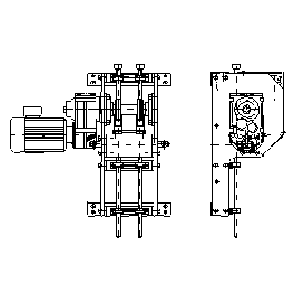Difference between revisions of "Frequency Controlled Drives"
| Line 1: | Line 1: | ||
[[Category:Actuators, Drives]]{{Knoppen}} | [[Category:Actuators, Drives]]{{Knoppen}} | ||
[[File:Frequency controlled drive.png|thumb|right|Frequency Controlled Drives]] | [[File:Frequency controlled drive.png|thumb|right|Frequency Controlled Drives]] | ||
'''Frequency Controlled Drive''' is a solid state power electronics conversion system consisting of three distinct sub-systems: a rectifier bridge converter, a direct current (DC) link, and an inverter. Voltage-source inverter (VSI) drives are by far the most common type of drives. Most drives are AC-AC drives in that they convert AC line input to AC inverter output. However, in some applications such as common DC bus or solar applications, drives are configured as DC-AC drives. The most basic rectifier converter for the VSI drive is configured as a three-phase, six-pulse, full-wave diode bridge. In a VSI drive, the DC link consists of a capacitor which smooths out the converter's DC output ripple and provides a stiff input to the inverter. This filtered DC voltage is converted to quasi-sinusoidal AC voltage output using the inverter's active switching elements. VSI drives provide higher power factor and lower harmonic distortion than phase-controlled current-source inverter (CSI) and load-commutated inverter (LCI) drives . The controller drive can also be configured as a phase converter having single-phase converter input and three-phase inverter output. | |||
'''Frequency | |||
Latest revision as of 20:27, 5 December 2012
Frequency Controlled Drive is a solid state power electronics conversion system consisting of three distinct sub-systems: a rectifier bridge converter, a direct current (DC) link, and an inverter. Voltage-source inverter (VSI) drives are by far the most common type of drives. Most drives are AC-AC drives in that they convert AC line input to AC inverter output. However, in some applications such as common DC bus or solar applications, drives are configured as DC-AC drives. The most basic rectifier converter for the VSI drive is configured as a three-phase, six-pulse, full-wave diode bridge. In a VSI drive, the DC link consists of a capacitor which smooths out the converter's DC output ripple and provides a stiff input to the inverter. This filtered DC voltage is converted to quasi-sinusoidal AC voltage output using the inverter's active switching elements. VSI drives provide higher power factor and lower harmonic distortion than phase-controlled current-source inverter (CSI) and load-commutated inverter (LCI) drives . The controller drive can also be configured as a phase converter having single-phase converter input and three-phase inverter output.
